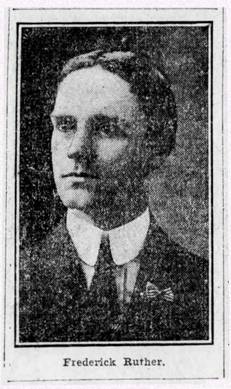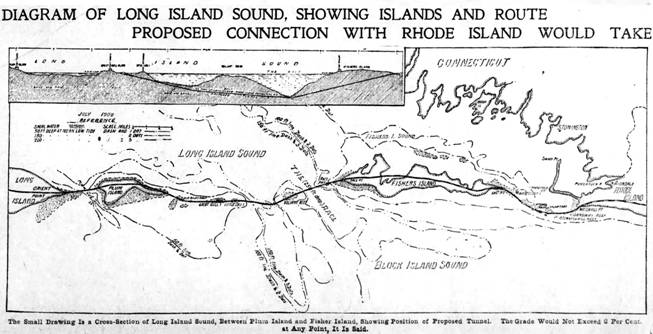Post Script: Something Completely Different

Brooklyn Daily Eagle, March 7, 1909
In 1909, young Hicksvillian Frederick Ruther was inspired by the promise of the tunnels between Manhattan and the lands across its rivers. He understood that Nassau would become a place of suburbs, but he had a novel - some would say a frightening - idea of what instead could, and what should, happen to Suffolk. He devised a proposal that showed how the Eastern part of Long Island could be made prosperous. It also was a way to accomplish other things which Ruther felt were important, such as generating work in Suffolk for people with technical educations, and making possible a restructuring of freight rates, so that eastbound and westbound freight transported by the LIRR would finally be subject to the same tariffs. Key to his proposal was a direct rail connection, running part way by bridge, part way by tunnel, across the Sound between Orient Point on Long Island and Watch Hill Point on the shoreline of Rhode Island.

Ruther was opposed to reserving parts of eastern L.I. as "playgrounds for the wealthy." For that matter, he saw little use for Suffolk's natural beauty, except perhaps for attracting a "better class" of wealthier tourists, who would spend more money at resorts. He lamented that Long Island's hundreds of miles of coastline were being wasted, because the "sea coast, with all its deep harbors and bays, is of no value to the manufacturer."
In his proposal, the Long Island Railroad was to become a connecting railroad for the shipment of manufactured products and raw materials, a link between New England and (via the tunnels to New York City) "All Points West." Better access to new markets and materials would spark an industrial boom in all of Long Island. Clearly not inclined to be modest, Ruther predicted that his proposal's economic benefit upon the Eastern United States would exceed the transformation which the Erie Canal had triggered a century before. He foresaw steady and enduring growth, so that people could work where they lived, leaving no room in the east for commuters from NYC. As they grew, all the villages and towns would blend into one. In Frederick Ruther's vision of a happy future, prosperity would "make one big city of Long Island." Imagine that!

Of course, his proposal fell mostly upon unreceptive - not necessarily deaf - ears, for there were many arguments against it. To the north, several other railroads already had effective freight links between New England and the West, links which bypassed Greater New York. If there was any merit to connecting LIRR rail freight service to Rhode Island, to some degree that could be accomplished putting freight cars on "car floats" (i.e., barges with railroad track on their decks) and using tugboats to get them across the Sound. For higher volumes of freight, plans were already being finalized for the Hellgate Bridge, which in a few years would serve as a direct freight rail connection with New England.
In his proposal, Ruther does not discuss the details of a through freight connection from the LIRR to western railroads. The reader might infer that the freight trains he discusses could travel through the new tunnels then being built for use by the Pennsylvania Railroad and the LIRR. Not so - those tunnels were designed to withstand only the load of passenger trains; freight trains would weigh significantly more. Regardless, for the sake of safety, rail tunnels beneath New York City were restricted to trains moved by electric power. It would be almost two decades before an electric locomotive suitable for heavy-duty freight would be in service anywhere in the country. Until then, batches of freight cars - not trains - would continue to creep across New York Harbor on car floats. All the region's railroads already owned tugs, floats, and special docks for that purpose.

New York Central Railroad tugboat moving a float of boxcars in the harbor
Museum of the City of New York
https://collections.mcny.org
In addition to the apparent impracticalities, the proposal presented a conceptual challenge, the implications of which could be sweeping. From the beginning of European settlement, development had been shaped by the land's being an island. Roadways ran from the shore to inland, or from shore to shore. As Manhattan grew from a handful of Dutch houses to the most populous city in the country, Long Island responded to its neighbor's eminence, and the east-west routes of transportation became dominant. Brooklyn long was a buffer between the City and Long Island. As Brooklyn grew to be the country's second-largest city, it tried to present itself as an alternative to New York (in the same way that 7up used to identify itself as The Un-Cola). After a while, people considered the Island an adjunct to Manhattan, not to mainland America. As a whole, the Island was a destination, not someplace to pass through on the way to somewhere else.
Constructing the link that Ruther proposed would guarantee nothing to Suffolk County, except for long freight trains running non-stop through it. Was it necessarily true that new Suffolk industries would be a logical part of a cross-country rail service, or would the requisite local access points just get in the way?
Let's say that local industry did blossom. Jobs might make it necessary for people to frequently travel back and forth between Long Island and the factories of Rhode Island and Massachusetts. Some people from one side would commute to the other. Others would pack and move their homes across the Sound. The New Haven and the Long Island might merge into a single railroad. Eventually, the mega-city of Long Island would lose its "island" identity, and be just one more "someplace" through which people happened to pass.
*
From time to time, Frederick Ruther made other, less grandiose proposals. One was to develop the deep natural harbor of Greenport into a transatlantic port, which would have meant creating a smaller version of New York's waterfront with busy docks, warehouses, fuel dumps, cranes, etc., so that freight could be moved back and forth between ships and the LIRR. The town of Greenport seemed to be much in favor of the idea.
While waiting for the world to embrace his foresight and reinvent itself, Ruther worked as a real estate agent, first in Hicksville, and later in Center Moriches. Occasionally, he organized tours of Eastern L.I., some of them quite lengthy, in which he shared his extensive knowledge of the area's history and geography. He also wrote books, with photographs which now are of great interest to local historians.
*****
Finito!

